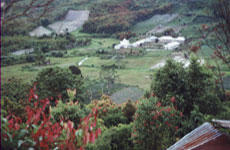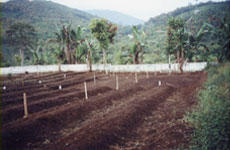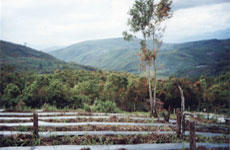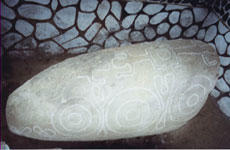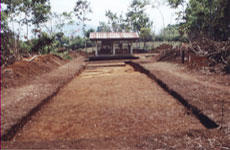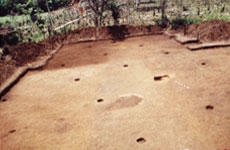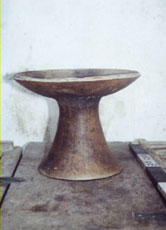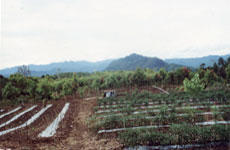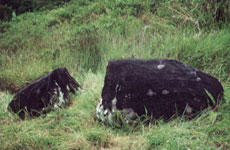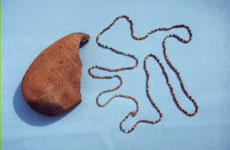Short report of the 1st archaeological campaign
Short report of the 1st archaeological campaign in Kerinci (Indonesia)
from the 4th August to the 25th of September 2003
The highland of Kerinci is situated south of the equator in the West of Sumatra. Toponym of the region is the Gunung Kerinci in the North, the highest volcano on Sumatra of 3085m and the Kerinci-lake in the South on 783 above sea level. In the past the region was an important provider of mineral resources and forest products. Gold, ivory and the luxury goods of benzoin and camphor are mentioned in Chinese, Indian and Arabic sources.
With the access to these goods for instance in the 7th century the Srivijaya Empire, situated in the lowland of Sumatra, gained an important rise as the central see emporium of the Indian Ocean. For Kerinci the oldest historical sources are not older than the 18th century. Older devices of settlement activities are the archaeological remains like ceramics, stone artefacts and numerous megaliths.
|
|
|
|
Fig. 1 |
Fig. 2 |
In summer 2003 the region south of the Kerinci-lake is focused by our archaeological research sponsored by the Swiss-Liechtenstein Foundation for Archaeological Research Abroad (SLSA). The international research team consisted of members of the university of Bern/Switzerland, Freiburg and Leipzig/Germany, Leiden/The Netherlands and the archaeological research center in Jakarta/Indonesia and the archaeological preservation unit of Jambi/Indonesia.
The archaeological activities were the following:
-
the archaeological excavation in Sungai Hangat in the river delta of the Air Hitam (fig. 1-2)
-
the archaeological survey in the area of Sungai Hangat (fig. 3)
-
the archaeological survey in the area of the Pondok megalith (fig. 4-6)
-
the archaeological excavation near the megalith of Pondok (fig. 8-9)
|
|
The research revealed finds of the settlement history of Kerinci in the 2nd century BC. The finds from the two survey-areas prove a dense settlement pattern south of the Kerinci-lake. |
|
| Fig. 3 | ||
|
The basis for this settlement density and settlement continuity might be the agrarian surplus of the extremely fertile region which was gained by the trade connections to the lowlands. Since the middle of the 2nd century BC the archaeological finds manifest the continuity of trade relations documented in secondary written sources. |
|
|
| Fig. 4 | ||
|
|
|
|
| Fig. 5 | Fig. 6 |
|
The excavation in Sungai Hangat provides finds of the pre-colonial, meaning the Islamic period, and the colonial phase under the Dutch. There a relatively wealthy settlement place in the river valley can be documented. This wealth, which is manifested in the rich repertoire of ceramics, including various Chinese imports and other smallfinds, might be connected to the strategic position at the Sungai Hangat-river as an important controlling centre for the trade. One specific item of the artisan specialization is a bowl with a high cylindrical foot which was found in numerous numbers (fig. 7). |
|
|
|
Fig. 7 |
The pottery of Sungai Hangat marks the end of the ceramic tradition in the Kerinci-area, because in the course of the first half of the 20th century the production ended. Therefore, the excavated ceramics provide a basis for further typological and chronological studies.
|
|
|
|
Fig. 8 |
Fig. 9 |
The excavations in Pondok including the megalith highlight the settlement continuity between the 12th and 16th century BC. Hints of an earlier habitation are not found. The site gives a good example of the importance of a one-phase settlement in order to reconstruct the regional history.
|
The documentation of a big house (fig. 6) next to the megalith and the artefacts found in close relation to it (fig. 10) are a unique find complex in the archaeology of Sumatra. This gives new insights in the research of megalithic remains in the Indonesian archipelago. |
|
|
|
|
|
Fig. 10 |
The pottery of Pondok which is older than that one of Sungai Hangat will be the basis for more research into the typological, stylistic and technological development of ceramics in the region. Up to now the Pondok ceramics is the oldest material found in a sound archaeological context in the West Sumatra highlands. Therefore the future ambition will be directed to find or proof older contexts in this region.

